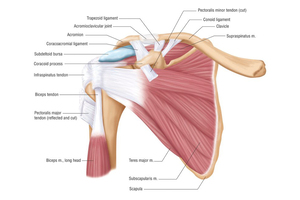The Shoulder
Recently I’ve had a few patients complaining of shoulder pain. Most of them had quite specific anterior shoulder pain on certain movements. Nothing new so far…
We were successful in treating the problem and restoring the full range of movement at the shoulder. But it doesn’t end there…
Many patients make the mistake of stopping active treatment as soon as the pain has gone. Come to think of it, many Physiotherapists are guilty of not insisting that their patients continue rehabilitation in order to bring about a more permanent change and reduce the risk of recurrence.
And no, we’re not simply talking about continuing to take your hard-earned cash to line our pockets! We really do care about getting you back to your best and believe it or not, we don’t want to see you back in the clinic with the same problem next month…because it feels like we’ve failed!
Keep that shoulder in shape
When pain free movement is restored it’s time to strengthen and address the muscle imbalance issues that contributed to the problem in the first place. So, off to the gym we go… (If you really hate the gym, don’t panic, I can show you some really effective exercises to do at home).
The shoulder is pretty complex…

See what I mean! Don’t worry, we’re keeping it simple…
Like all joints, we need our muscle groups to work together effectively in order to produce efficient movement. More often than not in the shoulder, certain muscles are working way more than others which leads to an imbalance and therefore a change in the alignment of the joint structures. Basically this can cause bits to get pinched, squeezed and just plain irritated…cue the pain.
Due to work and lifestyle factors, many of us end up with overactive upper traps and underactive lower traps/serratus anterior muscles. This dodgy combo gives us the well-known “shoulder hunch” and leaves our shoulder blades feeling a bit wobbly.
Studies have shown, using fancy muscle analysis techniques, that when we perform any arm exercises while standing or sitting, our upper traps are highly active – not ideal considering what we just talked about.
But when we exercise in prone or in side lying, the busybody upper traps chill out a bit and the lower traps get to join in the party!
Diagonally performed arm exercises get the serratus anterior involved too…
Some ideas to exercise that shoulder
Here are some ideas (Don’t laugh until you’ve tried them, they’re harder than you think!):

So, in a nutshell:
If you can relate to any of the above shoulder issues, or even if you’ve had similar symptoms in the past, it’s probably a good idea to get some guidance on strengthening exercises that will ensure the right muscle is doing the right job!
Otherwise, all the blood, sweat and tears lost in the gym might not be working in your favour after all (and that would be really annoying!).
